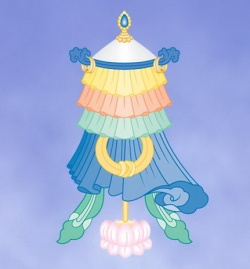Difference between revisions of "Eight kinds of vijjā"
| Line 4: | Line 4: | ||
| − | [[Vijja]],(adj.) (--°) (=[[vijjā]]) having [[vijjā]],possessed of [[wisdom]]; in [[vatthu]] | + | [[Vijja]],(adj.) (--°) (=[[vijjā]]) having [[vijjā]],possessed of [[wisdom]]; in [[vatthu]],[[tiracchāna]] ,[[nakkhatta]]° etc.(referring to the lower [[arts]] condemned as {{Wiki|heretic}}:[[vijjā]] c.) S.III,239.te° possessed of threefold wisdom:see [[vijjā]] b.(Page 617) |
-- or -- | -- or -- | ||
| Line 14: | Line 14: | ||
The opposite of [[avijjā]] is usually [[ñāṇa]] (but cp.S.III,162 f.171; V,429). | The opposite of [[avijjā]] is usually [[ñāṇa]] (but cp.S.III,162 f.171; V,429). | ||
| − | Although certain [[vijjās]] pertain to the {{Wiki|recognition}} of the “[[truth]]” and the destruction of | + | Although certain [[vijjās]] pertain to the {{Wiki|recognition}} of the “[[truth]]” and the destruction of [[avijjā]],yet they are only secondary factors in achieving “[[vimutti]]” (cp.[[abhiññā,ñāṇa-dassana]] & [[paññā]]). |
That [[vijjā]] at M.I,22 is contrasted with [[avijjā]] is to be expld as a word-play in a stereotype [[phrase]].-- | That [[vijjā]] at M.I,22 is contrasted with [[avijjā]] is to be expld as a word-play in a stereotype [[phrase]].-- | ||
| − | A diff.side of “[[knowledge]]” again is given by “[[bodhi]].” ‹-› (a) [[Vijjā]] is a general,popular term for lore in the old sense,science,study,esp.study as a practice of some [[art]] (something like the secret [[science]] of the [[medicine]] | + | A diff.side of “[[knowledge]]” again is given by “[[bodhi]].” ‹-› (a) [[Vijjā]] is a general,popular term for lore in the old sense,science,study,esp.study as a practice of some [[art]] (something like the secret [[science]] of the [[medicine]] man:cp.[[vejja]]!); |
hence appld in special,“dogmatic” [[sense]] as “secret [[science]],” [[revelation]] (put into a sort of [[magic]] formula),higher [[knowledge]] (of the learned man),knowledge which may be applied and used as an [[art]] (cp.magister artium!),practical [[knowledge]]; but also mysterious knowledge:“charm.” -- | hence appld in special,“dogmatic” [[sense]] as “secret [[science]],” [[revelation]] (put into a sort of [[magic]] formula),higher [[knowledge]] (of the learned man),knowledge which may be applied and used as an [[art]] (cp.magister artium!),practical [[knowledge]]; but also mysterious knowledge:“charm.” -- | ||
| Line 24: | Line 24: | ||
(b) vijjā,having a varying content in its connotation,is applied to a series of diff.achievements. | (b) vijjā,having a varying content in its connotation,is applied to a series of diff.achievements. | ||
| − | A rather old tabulation of the stages leading by degrees to the [[attainment]] of the [[highest knowledge]] is given in the [[Sāmañña-phala-sutta]] (D.I,63--86),repeated in nearly every [[Suttanta]] of D 1.It is composed of the 3 | + | A rather old tabulation of the stages leading by degrees to the [[attainment]] of the [[highest knowledge]] is given in the [[Sāmañña-phala-sutta]] (D.I,63--86),repeated in nearly every [[Suttanta]] of D 1.It is composed of the 3 [[sampadās]],viz.sīla°,[[citta]] & [[paññā]].Under the first group belong sīla(--kkhandha),indriya-saṃvara,sati-sampajañña,santuṭṭhi; |
the second is composed | the second is composed | ||
| − | (1) of the [[overcoming]] of the | + | (1) of the [[overcoming]] of the [[nīvaraṇas]], |
(2) of the 4 [[jhānas]]; the third consists of 8 items,viz. | (2) of the 4 [[jhānas]]; the third consists of 8 items,viz. | ||
(1) [[ñāṇa-dassana]], | (1) [[ñāṇa-dassana]], | ||
| − | (2) manomaya- | + | (2) [[manomaya-kāya]], |
(3) [[iddhi]], | (3) [[iddhi]], | ||
(4) [[dibba-sota]], | (4) [[dibba-sota]], | ||
| − | (5) ceto- | + | (5) [[ceto-pariyañāṇa]], |
| − | (6) pubbe- | + | (6) [[pubbe-nivās’ânussatiñāṇa]], |
| − | (7) cut’ûpapatti- | + | (7) [[cut’ûpapatti-ñāṇa]], |
| − | (8) āsavānaṃ khaya- | + | (8) [[āsavānaṃ khaya-ñāṇa]]. |
Other terms used are:for the 2nd sampadā:caraṇa (D.I.100),and for the 3rd:vijjā (ibid.). | Other terms used are:for the 2nd sampadā:caraṇa (D.I.100),and for the 3rd:vijjā (ibid.). | ||
| − | The [[discussion]] at D.I,100 is represented as contradicting the | + | The [[discussion]] at D.I,100 is represented as contradicting the ([[brahmaṇic]]) opinion of Ambaṭṭha,who [[thought]] that “[[vijjā]] [[nāma]] tayo Vedā,caraṇaṃ [[pañca sīlāni]]” (DA.I,267 sq.).-- |
| − | In the enumn of 3 [[vijjās]] at M.I,22 sq.only Nos.6--8 of the 3rd sampadā (said to have been [[attained]] by the [[Buddha]] in the 3 night watches) with the verbs anussarati | + | In the enumn of 3 [[vijjās]] at M.I,22 sq.only Nos.6--8 of the 3rd [[sampadā]] (said to have been [[attained]] by the [[Buddha]] in the 3 night watches) with the verbs [[anussarati]] |
| − | + | (No.6),[[pajānāti]] | |
| + | |||
| + | (7),abhijānāti (8),each signifying a higher stage of (“saving”) knowledge,yet all called “[[vijjā]].” Quoted at Vism.202,where all 8 stages are given as “aṭṭha [[vijjā]],” and [[caraṇa]] with 15 qualities (sīla-saṃvara,indriyesu guttadvāra etc.). | ||
The same 3 [[vijjās]] (No.6,7,8) are given at D.III,220,275,and poetically at A.II,165 as the [[characteristics]] of a proper (ariya,Buddhist) [[monk]] (or brāhmaṇa):“etāhi tīhi vijjāhi tevijjo hoti brāhmaṇo,” opposing the three Veda-knowledge of the [[Brahmins]].-- [[Tevijja]] (adj.) | The same 3 [[vijjās]] (No.6,7,8) are given at D.III,220,275,and poetically at A.II,165 as the [[characteristics]] of a proper (ariya,Buddhist) [[monk]] (or brāhmaṇa):“etāhi tīhi vijjāhi tevijjo hoti brāhmaṇo,” opposing the three Veda-knowledge of the [[Brahmins]].-- [[Tevijja]] (adj.) | ||
| Line 55: | Line 57: | ||
[[Tisso vijjā]] (without specification,but referring to above 6,7,8) further at Vin.II,183; Sn.656; Ps.I,34; II,56; Pv IV.134; Miln.359 (+chaḷabhiññā); DhA.IV,30 (id.).It is [[doubtful]] whether the defn of [[ñāṇa]] as “[[tisso vijjā]]” at Vin.III,91 is genuine. | [[Tisso vijjā]] (without specification,but referring to above 6,7,8) further at Vin.II,183; Sn.656; Ps.I,34; II,56; Pv IV.134; Miln.359 (+chaḷabhiññā); DhA.IV,30 (id.).It is [[doubtful]] whether the defn of [[ñāṇa]] as “[[tisso vijjā]]” at Vin.III,91 is genuine. | ||
| − | On vijjā-caraṇa see also D.III,97,98,237; S.I,153,166; II,284; V,197; A.II,163; IV,238; V,327; Sn.163,289,442.-- On [[vijjā]] in the [[doctrinal]] appln see:D.III,156,214,274; S.II,7 | + | On [[vijjā-caraṇa]] see also D.III,97,98,237; S.I,153,166; II,284; V,197; A.II,163; IV,238; V,327; Sn.163,289,442.-- On [[vijjā]] in the [[doctrinal]] appln see:D.III,156,214,274; S.II,7 sq.([[cakkhu]],[[ñāṇa]],[[paññā]],[[vijjā]],[[āloka]]); III,47; 163; 171; IV,31,49 sq.A.I,83; II,247; Sn.334 (simply meaning “[[wisdom]],” craft,care, |
| − | but Bdhgh SnA 339 takes it as | + | but Bdhgh SnA 339 takes it as “[[āsavānaṃ--khaya-ñāṇa]]”),1026 (opposed to [[avijjā]]); Pug.14,57; Vbh.324; Nett 76,191.-- (c) popular meanings & usage of vijjā:science,craft,art,charm,spell D.I,213 ([[Gandhārī nāma]] v.also mentioned at J.IV,498 as practised by physicians),214 (Maṇika n.v.); J.III,504 ([[Cintāmaṇi]] v.); IV,323 (vatthu°:see under vatthu),498 (ghora°); V,458 ([[aṅga]]° {{Wiki|palmistry}}); Miln.200; Dh.I,259 ([[bhūmicala]] n.v.“earthquake” charm),265 ([[dhanu-agamanīyaṃ Ambaṭṭha]] n.v.); KhA 237 ([[vatthu]],[[khetta]],[[aṅga]]); and see the list of forbidden crafts at D.I,9 (aṅga°,vatthu°,khetta° etc.; cp.Dial.I.18,19). |
--[[gata]] [[having attained]] [[wisdom]] Sn.730 (opp.avijjā; the playful expln at SnA 505 is “ye arahatta-maggavijjāya kilese vijjhitvā gatā khīṇāsava-sattā”).--caraṇa (-[[sampanna]]) (endowed with) special craft ([[wisdom]]) & virtue:see above,b.--ṭṭhāna branch of study; | --[[gata]] [[having attained]] [[wisdom]] Sn.730 (opp.avijjā; the playful expln at SnA 505 is “ye arahatta-maggavijjāya kilese vijjhitvā gatā khīṇāsava-sattā”).--caraṇa (-[[sampanna]]) (endowed with) special craft ([[wisdom]]) & virtue:see above,b.--ṭṭhāna branch of study; | ||
| − | there are 18 vijja-ṭṭhānāni or “[[arts]] & [[sciences]],” [[subjects]] of study,referred to at J.I,259.--dhara a knower of charms,a sorcerer J.III,303,529; IV,496; V,94; Miln.153,200,267.--bhāgiyā ([[dhammā]]) (states) conducive to [[wisdom]] (6 kinds of [[saññā]]) A.III,334; cp.D.III,243; S.V,395; A.IV,52 sq.--mayā ([[iddhi]]) ([[potency]]) accomplished by [[art]] or [[knowledge]] (Expos.I.122) Vism.383; see | + | there are 18 [[vijja-ṭṭhānāni]] or “[[arts]] & [[sciences]],” [[subjects]] of study,referred to at J.I,259.--dhara a knower of charms,a sorcerer J.III,303,529; IV,496; V,94; Miln.153,200,267.--[[bhāgiyā]] ([[dhammā]]) (states) conducive to [[wisdom]] (6 kinds of [[saññā]]) A.III,334; cp.D.III,243; S.V,395; A.IV,52 sq.--[[mayā]] ([[iddhi]]) ([[potency]]) accomplished by [[art]] or [[knowledge]] (Expos.I.122) Vism.383; see [[iddhi]].--[[vimutti]] [[wisdom]] ([[higher knowledge]]) as {{Wiki|salvation}} S.V,28,335 sq.; Ps.II,243 (in detail).(Page 617) |
{{R}} | {{R}} | ||
http://www.wisdomlib.org/definition/vijja/index.html | http://www.wisdomlib.org/definition/vijja/index.html | ||
{{PaliTerminology}} | {{PaliTerminology}} | ||
Latest revision as of 10:22, 7 March 2016
Vijja,(adj.) (--°) (=vijjā) having vijjā,possessed of wisdom; in vatthu,tiracchāna ,nakkhatta° etc.(referring to the lower arts condemned as heretic:vijjā c.) S.III,239.te° possessed of threefold wisdom:see vijjā b.(Page 617)
-- or --
Vijjā,(f.) (cp.Vedic vidyā knowledge :etym.see under vindati) one of the dogmatic terms of Buddhist teaching,varying in meaning in diff.sections of the Canon.
It is not always the positive to avijjā (which has quite a welldefined meaning from its first appearance in Buddhist psych.ethics),but has been taken into the terminology of Buddhism from Brahmanic and popular philosophy.
The opposite of avijjā is usually ñāṇa (but cp.S.III,162 f.171; V,429).
Although certain vijjās pertain to the recognition of the “truth” and the destruction of avijjā,yet they are only secondary factors in achieving “vimutti” (cp.abhiññā,ñāṇa-dassana & paññā).
That vijjā at M.I,22 is contrasted with avijjā is to be expld as a word-play in a stereotype phrase.--
A diff.side of “knowledge” again is given by “bodhi.” ‹-› (a) Vijjā is a general,popular term for lore in the old sense,science,study,esp.study as a practice of some art (something like the secret science of the medicine man:cp.vejja!);
hence appld in special,“dogmatic” sense as “secret science,” revelation (put into a sort of magic formula),higher knowledge (of the learned man),knowledge which may be applied and used as an art (cp.magister artium!),practical knowledge; but also mysterious knowledge:“charm.” --
(b) vijjā,having a varying content in its connotation,is applied to a series of diff.achievements.
A rather old tabulation of the stages leading by degrees to the attainment of the highest knowledge is given in the Sāmañña-phala-sutta (D.I,63--86),repeated in nearly every Suttanta of D 1.It is composed of the 3 sampadās,viz.sīla°,citta & paññā.Under the first group belong sīla(--kkhandha),indriya-saṃvara,sati-sampajañña,santuṭṭhi;
the second is composed
(1) of the overcoming of the nīvaraṇas, (2) of the 4 jhānas; the third consists of 8 items,viz.
(1) ñāṇa-dassana, (2) manomaya-kāya, (3) iddhi, (4) dibba-sota, (5) ceto-pariyañāṇa, (6) pubbe-nivās’ânussatiñāṇa, (7) cut’ûpapatti-ñāṇa, (8) āsavānaṃ khaya-ñāṇa.
Other terms used are:for the 2nd sampadā:caraṇa (D.I.100),and for the 3rd:vijjā (ibid.).
The discussion at D.I,100 is represented as contradicting the (brahmaṇic) opinion of Ambaṭṭha,who thought that “vijjā nāma tayo Vedā,caraṇaṃ pañca sīlāni” (DA.I,267 sq.).--
In the enumn of 3 vijjās at M.I,22 sq.only Nos.6--8 of the 3rd sampadā (said to have been attained by the Buddha in the 3 night watches) with the verbs anussarati
(No.6),pajānāti
(7),abhijānāti (8),each signifying a higher stage of (“saving”) knowledge,yet all called “vijjā.” Quoted at Vism.202,where all 8 stages are given as “aṭṭha vijjā,” and caraṇa with 15 qualities (sīla-saṃvara,indriyesu guttadvāra etc.).
The same 3 vijjās (No.6,7,8) are given at D.III,220,275,and poetically at A.II,165 as the characteristics of a proper (ariya,Buddhist) monk (or brāhmaṇa):“etāhi tīhi vijjāhi tevijjo hoti brāhmaṇo,” opposing the three Veda-knowledge of the Brahmins.-- Tevijja (adj.)
in same meaning at S.I,146 (where it refers to Nos.3,5,8 of above enumn),192,194.In brahmanic sense at Sn.594 (=tiveda SnA 463).Both meanings compared & contrasted at A.I,163 (aññathā brāhmaṇā brāhmaṇaṃ tevijjaṃ paññāpenti,aññathā ca pana ariyassa vinaye tevijjo hoti “different in the Brahmanic and diff.in the Buddhist sense”).--
Tisso vijjā (without specification,but referring to above 6,7,8) further at Vin.II,183; Sn.656; Ps.I,34; II,56; Pv IV.134; Miln.359 (+chaḷabhiññā); DhA.IV,30 (id.).It is doubtful whether the defn of ñāṇa as “tisso vijjā” at Vin.III,91 is genuine.
On vijjā-caraṇa see also D.III,97,98,237; S.I,153,166; II,284; V,197; A.II,163; IV,238; V,327; Sn.163,289,442.-- On vijjā in the doctrinal appln see:D.III,156,214,274; S.II,7 sq.(cakkhu,ñāṇa,paññā,vijjā,āloka); III,47; 163; 171; IV,31,49 sq.A.I,83; II,247; Sn.334 (simply meaning “wisdom,” craft,care,
but Bdhgh SnA 339 takes it as “āsavānaṃ--khaya-ñāṇa”),1026 (opposed to avijjā); Pug.14,57; Vbh.324; Nett 76,191.-- (c) popular meanings & usage of vijjā:science,craft,art,charm,spell D.I,213 (Gandhārī nāma v.also mentioned at J.IV,498 as practised by physicians),214 (Maṇika n.v.); J.III,504 (Cintāmaṇi v.); IV,323 (vatthu°:see under vatthu),498 (ghora°); V,458 (aṅga° palmistry); Miln.200; Dh.I,259 (bhūmicala n.v.“earthquake” charm),265 (dhanu-agamanīyaṃ Ambaṭṭha n.v.); KhA 237 (vatthu,khetta,aṅga); and see the list of forbidden crafts at D.I,9 (aṅga°,vatthu°,khetta° etc.; cp.Dial.I.18,19).
--gata having attained wisdom Sn.730 (opp.avijjā; the playful expln at SnA 505 is “ye arahatta-maggavijjāya kilese vijjhitvā gatā khīṇāsava-sattā”).--caraṇa (-sampanna) (endowed with) special craft (wisdom) & virtue:see above,b.--ṭṭhāna branch of study;
there are 18 vijja-ṭṭhānāni or “arts & sciences,” subjects of study,referred to at J.I,259.--dhara a knower of charms,a sorcerer J.III,303,529; IV,496; V,94; Miln.153,200,267.--bhāgiyā (dhammā) (states) conducive to wisdom (6 kinds of saññā) A.III,334; cp.D.III,243; S.V,395; A.IV,52 sq.--mayā (iddhi) (potency) accomplished by art or knowledge (Expos.I.122) Vism.383; see iddhi.--vimutti wisdom (higher knowledge) as salvation S.V,28,335 sq.; Ps.II,243 (in detail).(Page 617)



